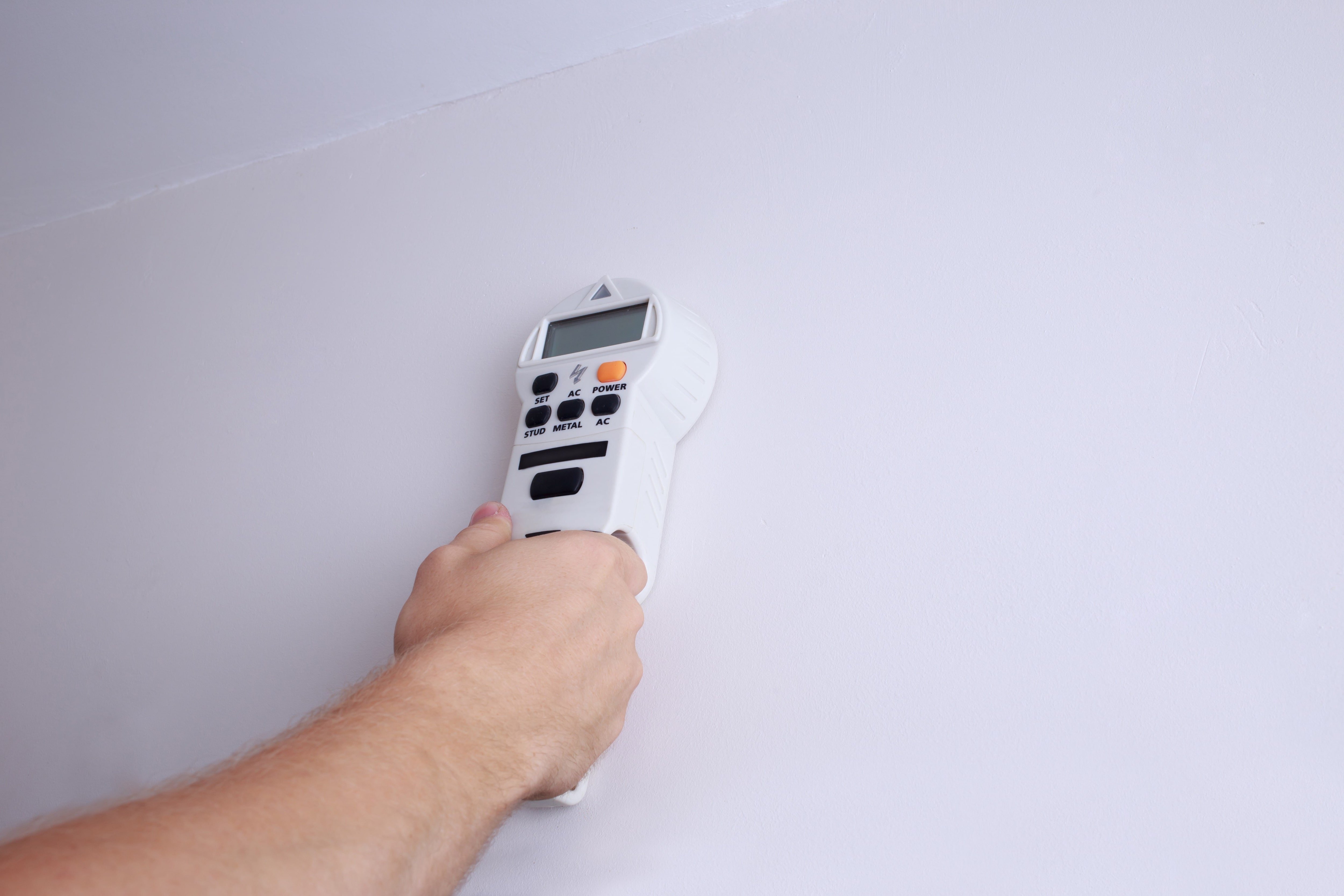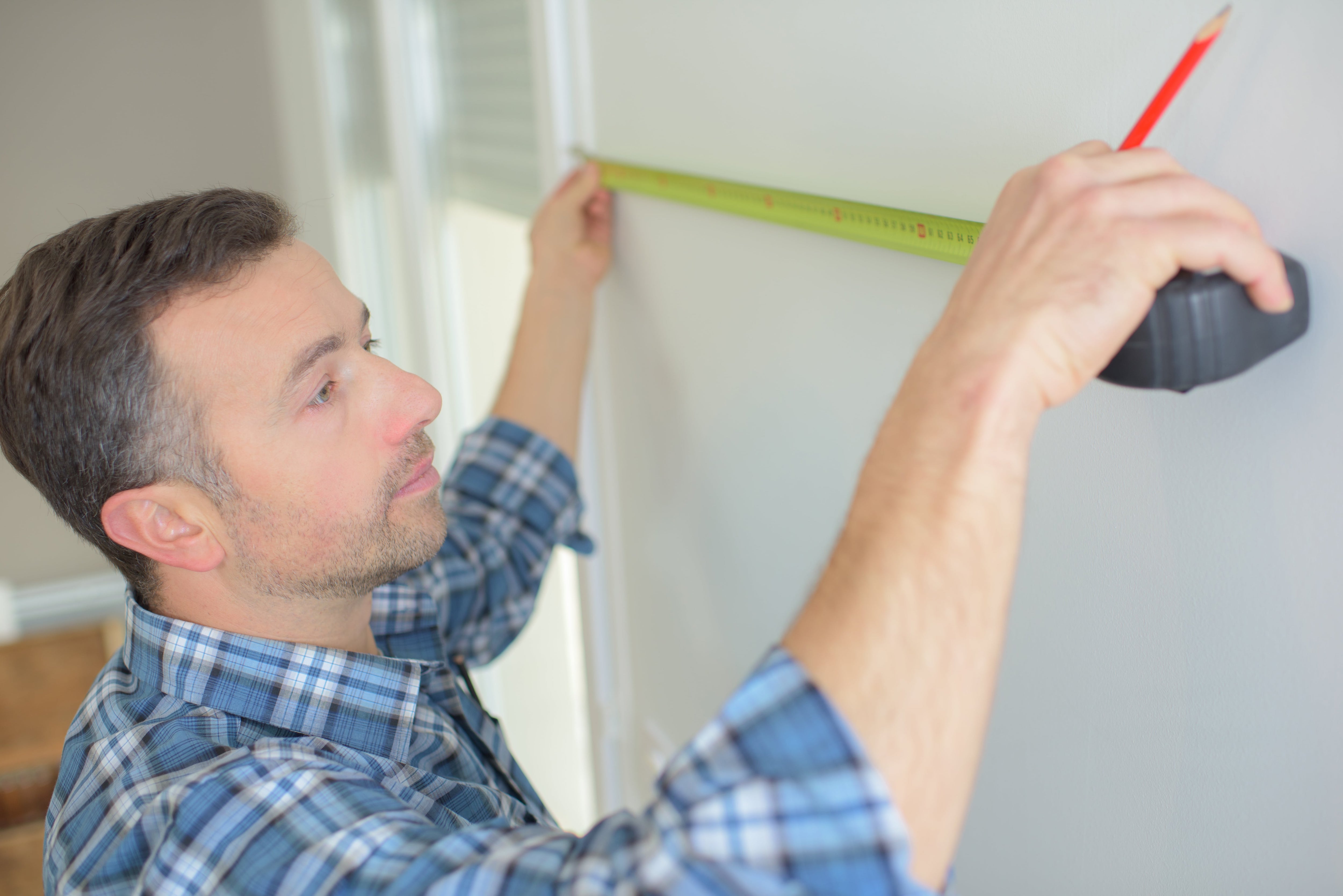How to Hang a Heavy Mirror in 5 Simple Steps
You won’t have to worry about 7 years of bad luck again


- Wall anchor
- Screws
- Mounting fasteners
- Painter’s tape (optional)
- Pencil
Note: Depending on the mounting hardware you choose and the type of wall material you are working with, the materials and tools needed may vary.
Hanging a large mirror is a quick and easy way to open up a room, making the area feel larger and brighter without the hassle of painting. Superstitious or not, it’s important to fasten a mirror to the wall correctly the first time you hang it. While visually striking, a large mirror can pose a potential safety hazard if installed incorrectly. Follow these steps to make sure your heavy mirror is secure the first time you hang it.
How to Hang a Heavy Mirror
Use this guide to learn how to hang a heavy mirror and instantly update the look in your room.
Prep the Area and Evaluate the Mirror’s Specifications
 Photo: New Africa / Adobe Stock
Photo: New Africa / Adobe StockStart by assessing the space where you plan on mounting the mirror. Choose an area that is free from clutter and gives you enough vertical and horizontal clearance to place the mirror at eye level. Mark the wall with a pencil or painter’s tape if you are unsure, so you can better visualize it within the space.
Move furniture and other smaller objects from the area so you have enough space to work in. Also, clear out a path in your home so you can transport your mirror to its designated location without worrying about tripping over furniture or odds and ends. Dust and clean the wall before hanging the mirror because the wall will be harder to reach once it’s up.
If the mirror comes with product specifications, check the weight so you can pick the best mounting hardware (if fasteners weren’t included). If you are unsure of the weight of the mirror, simply weigh yourself with and without the mirror on a bathroom scale to determine how heavy it is.
Note: If the mirror is exceptionally large or heavy, don’t do it on your own. Instead, enlist the help of a friend or family member to allow for equal weight distribution.
Determine the Type of Wall Material
Assess the type of wall you will hang the mirror on to determine the best hardware to use. There are three main types of walls you could work with and each has different properties that can affect how you will secure it.
Drywall, sometimes referred to as sheetrock or gypsum board, is the most commonly used wall and ceiling material in homes built after the 1950s.
Plaster walls are made of lime or gypsum, and sand or cement, that hardens when mixed with water. Walls in older homes were installed using lath and plaster, usually a three-step process of laying the wood, then coating it with the plaster mixture.
Masonry refers to the laying of stone, brick, or cement to form interior or exterior walls.
If you are unsure if your walls are drywall or plaster, you can press a thumbtack into the surface. If the thumbtack easily penetrates through the wall, you are working with drywall. If you can’t push the thumbtack through, the material is likely plaster.
Locate the Wall Studs
 Photo: deviddo / Adobe Stock
Photo: deviddo / Adobe StockPicture hanging kits can work for small mirrors, but when you have something heavier, you will need the support of a wall stud or an anchor. Mounting a heavy mirror to a stud provides a secure base for it to attach to. Depending on how heavy the mirror is, using a wall stud is recommended but not obligatory. Read the section below to learn how to hang a heavy mirror without using a wall stud.
There are a few different ways you can look for a stud in the wall, so check out our guide on how to find a wall stud to determine the method that works best for you. Remember, before you drill into a wall, check for live wires and pipes behind the surface. To do this, use a multi-purpose stud finder, which can detect both studs and live wires behind the wall. Mark the center of the stud to ensure you are drilling directly into the middle of the wood.
When you hang a mirror, certain fasteners need to be attached to a screw in the stud of a wall. Otherwise, you will need to use anchors that can hold the weight of the mirror. If you are hanging a heavy mirror on drywall into a stud, you will need a 1-¼” screw. If you are screwing into a stud in plaster walls, you will need a longer screw, about 3”, to fully penetrate through all the layers of material.
If you are working with masonry, there won’t be any studs, so you will need to use an anchor and specific masonry drill bits, and a hammer to ensure it’s properly secured.
Choose the Right Hardware
After you have determined where you plan on hanging the mirror and assessed the type of wall material, learn about the different fasteners and pick the right one for your project (if the mirror doesn’t include hardware). Choose hardware rated for more than the mirror’s weight limit to ensure the piece is safely secured to the wall stud.
French cleat brackets: French cleats are a type of bracket used to hang heavy mirrors and artwork with two interlocking pieces. Locate the stud and attach one of the cleats to the back of the mirror and the other to the stud, so the two brackets interlock.
Picture wire: Hanging wire attaches to a fastener on the back of the mirror and stretches across the back of the frame. You can then hook the center of the wire to the wall screw (or two mounting points to two screws) to suspend the mirror in place. This method is preferable for light to medium-weight mirrors. However, you can use a thicker gauge hanging wire combined with D-rings and two mounting points to better secure a heavier mirror.
D-rings: This type of fastener is directly attached to the back of the mirror and is shaped like a “D” so you can latch the mirror directly on two hooks in the wall studs using the rungs of the fastener. They can be used on their own or combined with picture wire threaded through the rings.
Measure, Level, and Attach Hardware
 Photo: zephyr_p / Adobe Stock
Photo: zephyr_p / Adobe StockOnce you have chosen the hardware, measure the spacing of the fasteners and transfer these measurements to the wall to determine where to insert the screw.
Hanging French cleat brackets: Start by lining up the bottom cleat to the wall studs and aligning the center screw with the center of the stud. Place a level on the top of the bracket and mark the holes with a pencil once level. Using a drill or screwdriver, begin with the center hole, then work your way outwards. Line up the second cleat to the top edge of the frame and attach the screws. Then, simply hang the mirror so the two pieces interlock.
Hanging a mirror with picture wire: Identify two mounting points on the mirror that align with two mounting points on the wall (ideally directly into two studs). With the picture hanging wire taut, measure the distance between the two mounting points as well as the distance from the wire to the top of the frame. Transfer these measurements to the wall with a pencil and install the screws to the matching points. Use a level across the top of the two screws to ensure they are even. Carefully lift the mirror onto the two mounting points so the wire is suspended over the screws.
Hanging a mirror with D-rings without a wire: Measure the distance from the top of the mirror to the top of the rings. Then measure the distance between the two points and transfer these measurements to the wall. Install the screws into the wall using the coordinating measurements and use a level to get the two points even. With the rungs facing upwards, lift the mirror onto the wall screws and step back and enjoy your new piece.
How to Hang a Heavy Mirror Without a Wall Stud
Even though hanging a heavy mirror on a wall stud is best practice, there are some instances when the location that makes the most sense doesn’t have a stud behind it. In this scenario, you will need to first install an anchor that can hold the weight of the mirror or you risk the mirror falling out from the wall.
Drywall Anchors
Choose a drywall anchor that is rated to hold the weight of your mirror. If you pick an anchor that is not “self-drilling,” you will first need to make a pilot hole with your drill. Otherwise, you can simply apply medium pressure to a self-drilling anchor and manually twist it into the wall using a screwdriver. Keep screwing it into the wall until it is flush against the surface (but not embedded). Now, you can install a drywall screw into the anchor and hang the mirror with your chosen fastener.
Plaster Wall Bolts
If you have plaster walls, opt for a toggle bolt or a molly bolt rather than a traditional plastic anchor. This type of bolt expands through the layers of the plaster, taking the place of a stud. Toggle bolts will support more weight than a molly bolt so refer to the manufacturer's directions and weight ratings when choosing the best one for your project.
Molly bolt: Drill a pilot hole and tap the bolt into the hole with a hammer. Manually tighten it, allowing it to expand and grip to the wall once in place. Screw the bolt out from the sleeve so an anchored hole remains for you to hang your mirror from.
Winged toggle bolt: Drill a pilot hole then thread the bolt through the hole with the wings facing the head of the screw. Squeeze the wings and push it into the hole until flush against the wall. Tighten the bolt by pulling back on the threads of the bolt so the wings grip the wall. Once the wings have expanded, release the tension and manually tighten the bolt.
Masonry Anchors
If you are hanging a mirror on brick or another masonry, choose a plastic sleeve anchor or a masonry sleeve anchor and refer to the manufacturer’s instructions for installation. Remember, you will need specialized tools like a hammer drill and a specific masonry bit to complete the project.
Large Mirror Style Tips
When shopping for a mirror and deciding where to place it in the space, there are a few style tips to keep in mind to give your room that “wow” factor:
Consider other accents in the room you want to highlight such as artwork or photographs and place the mirror across from them so they are accentuated by the reflection from the mirror.
Keep a standalone mirror at eye level to create a focal point in the room.
Mirrors installed over mantels or buffets can be placed above or below eye level to account for a 3-7 inch space between the top of the furniture and the bottom edge of the mirror.
If you notice unwanted gaps between the wall and the mirror after hanging, use adhesive strips to reinforce the piece and keep it flush against the wall.
Mirrors will brighten up a room but be mindful of too much reflection in the space from windows or light fixtures.
Mirrors can be functional as well as a purely decorative accent and give the appearance of a larger room. Use a mirror with an ornamental frame in place of artwork that will match any color scheme.
















